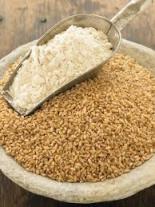Feb.19: COVER STORY
- Posted by CERC India
- Posted in FEBRUARY
Ten wheat flour brands tested: Is your brand okay?
Brands tested for 7 parameters and also for adulterants and contaminants
No meal is complete without hot, fluffy phulkas gently smeared with ghee to eat with dal and the sabzi of the day. Wheat flour or atta, which rotis are made of, is a staple in most Indian households.
How good is the quality of packaged wheat flour available in the market? To find an answer to this question, we tested samples of 10 brands of wheat flour.The good news was that all brands conformed to the parameters set by the Bureau of Indian Standards (BIS)and Food Safety and Standards Authority of India (FSSAI). Moreover, all brands were free from adulteration and contamination.
We tested the samples for the following parameters – moisture, total ash, acid insoluble ash, gluten, alcohol acidity, crude fibre and granularity. We also tested them for the presence of the following adulterants and contaminants – excess sand and dirt, excess bran, chalk powder, starch, insects and fungus.
KEY FINDINGS
(See table for detailed results)
- The moisture content in all the 10 brands were found to be complying with the mentioned BIS limit of Not More Than (NMT) 13.0% by weight, and FSSAI limit of NMT 14.0% by weight, with results ranging from 7.1- 11.2%. Flour with excess moisture content is likely to be attacked by microorganisms and insects. Over time, mould growth may develop.
- All the brands complied with the BIS as well as the FSSAI limits for total ash of NMT 2.0% on dry basis by weight. The ash of wheat flour consists principally of the phosphates of potassium and magnesium. The ash content of wholemeal flour is much higher than that of refined white flour.
- All the brands conformed to the BIS and FSSAI limits for acid insoluble ash of NMT 0.10% by weight on dry basis. A high value for acid insoluble ash suggests the presence of dust, dirt, stones which get mixed during processing or are present in the parent material as an adulterant.
- All the brands had gluten levels within the BIS limit of Not Less Than (NLT) 9.0% and FSSAI limits of NLT 6.0% by weight on dry basis. Very low gluten content frequently results in dough deterioration when machine handled, and also in baking faults.
- Crude fibre was found to be within the BIS limit of NMT 2.5% by weight in all the brands, ranging from 0.9-1.5%. Crude fibre gives an indication of adulteration of the sample with extraneous matter of plant origin.
- All the ten brands tested passed the test for alcoholic acidity with results below the BIS limit of 0.1% and FSSAI limit of 0.18% by weight. The acidity of flour increases during storage. Hence, alcoholic acidity provides an indication of the age of the flour.
- All the ten brands complied in the test for granularity. The texture of wheat and milling conditions determine granularity.
- Adulteration and contamination: None of the brands tested positive for adulteration or contamination. The presence of excess bran or chalk powder was not detected in any brand. Excess bran and/or chalk powder may be added to wheat flour to increase the bulk of the product. Dirt and insect infestation indicate a failure to maintain good sanitary conditions in grain storage areas and mills and inadequate cleaning of grains.
- Labelling requirements: All the brands complied with the FSS (Packaging and Labelling) Regulations 2011.
Best Buy
Patanjali obtained the highest overall score of 86 followed by Star Chakki Fresh at 85 and Aashirvaad at 83 respectively. If we compare the prices per 5 kg of the product, Patanjali is the least expensive at Rs. 160. Hence, with the best score and least price, Patanjali is our Best Buy.
Previous testing
The CERC laboratory had earlier tested 13 brands of wheat flour and the results were published in Insight, May-June 2000. Problems with respect to quality and labelling were observed then. Eight brands did not conform to alcohol acidity limits indicating that they were not fresh. Three brands had insect matter and 11 out of 13 brands had excess sand and dirt. Moreover, the labelling was inadequate, with three brands not even having the expiry date.
Role of gluten
Recently, there has been some fake news regarding presence of so-called ‘plastic’ in wheat flour. It is gluten, a natural component of wheat flour, which results in the elasticity of the dough. When water is added to flour and mixed to form dough, the proteins interact to form elastic, cohesive gluten.
 Areas of action
- Consumers should be made aware that it is always advisable to buy packaged food products instead of loose products.
- They should be informed about simple household tests for detecting adulteration.
- Wheat flour should be made available in smaller packaging, say, 1 kg.
- Regular monitoring of loose as well as packaged products by regulatory bodies is necessary to ensure safety and quality.
Grahak Sathi’s conclusion
It is indeed heartening news that all the brands of wheat flour tested proved to be good in terms of purity, freshness and overall quality. Branded wheat flour is more expensive than the unbranded product, but in the latter there is always the danger of adulteration or contamination due to unhygienic handling practices. That’s why it is always advisable for consumers to buy the packaged product.







